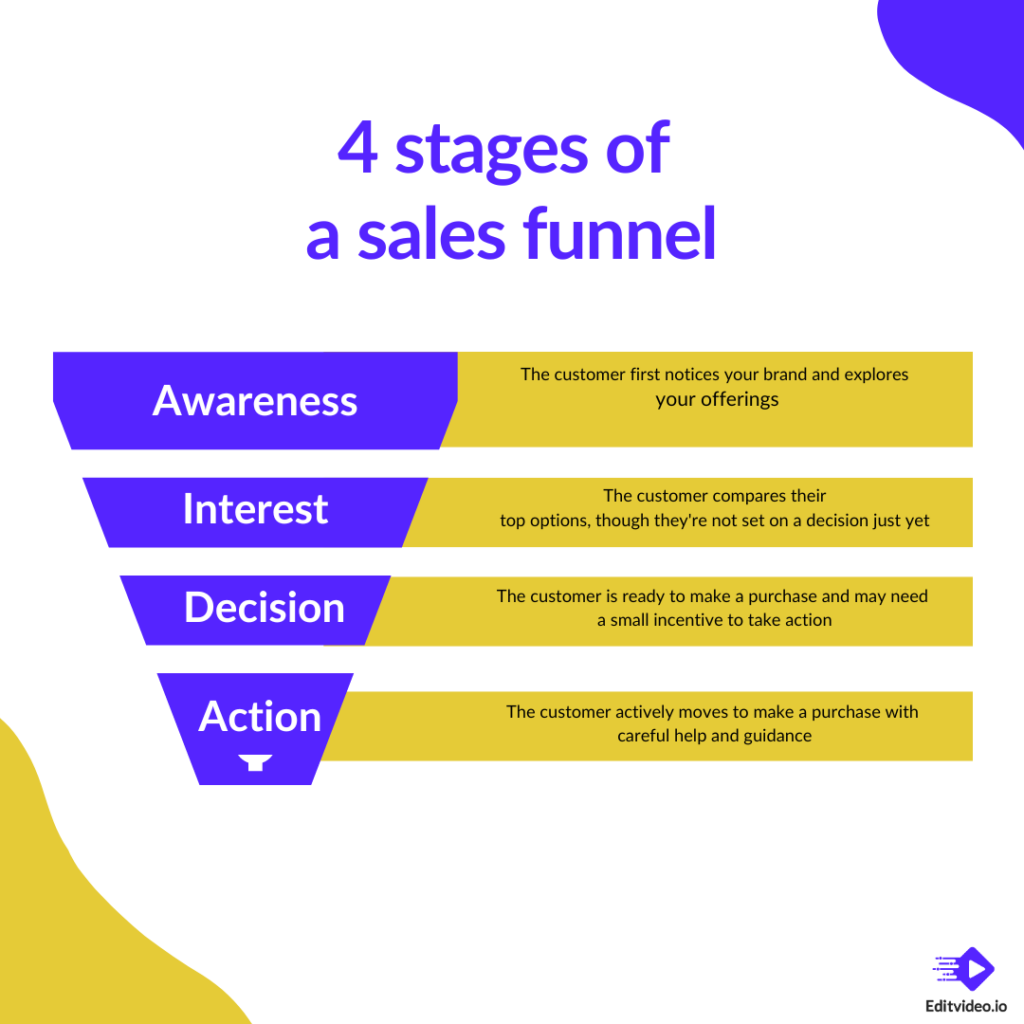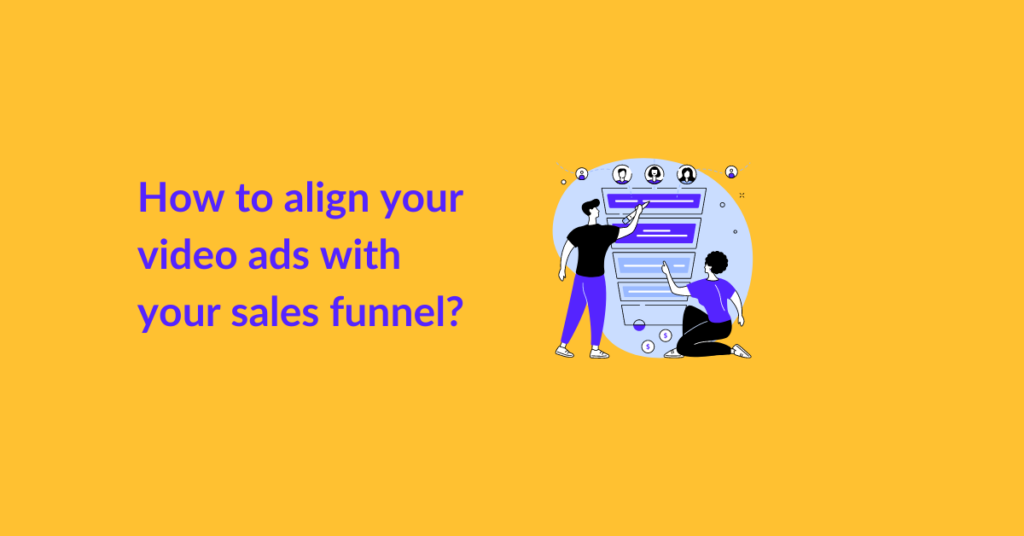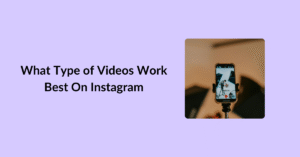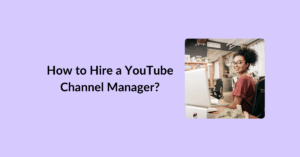Video ads have an average click-through rate of 1.84% —- which is by far the highest CTR of all digital formats.
This pretty much explains how much video ads contribute to a business’s sales or traffic generation. If you manage to nail this one piece of content, you might be able to enjoy a definite return on investment for every single penny.
To make the situation even more clear to you, here’s a more illustrative idea:
Professionally created & marketed video ads mean you won’t have to count on your luck to get subscribers, likes, or revisits. Instead, you would be sure that attention & money will soon roll in.
In our previous post, we’ve shown you how to create killer video ads. Now, it’s time to learn how to place these video ads in your sales funnel such that they bring you the maximum possible returns.
Let’s get started!
Table of Contents
What is a sales funnel?
A sales funnel represents a customer’s buying journey. It is a model used by businesses to convert potential customers into paying customers.
It is called a ‘funnel’ because it is shaped so. There’s a wide opening at the top and a narrow opening at the bottom.
Here’s a visual representation:

Now, the shape isn’t meaningless.
The wide opening represents the pool of potential customers, while the narrow opening represents the converted, paying customers.
Why do we use the ‘wide’ and ‘narrow’ representations? Why not any other shape?
It’s because it represents the practicality of the sales cycle. Here’s how:
- You could have 100 potential customers who noticed your brand. But only a handful will convert. Maybe 10. Or even one. It depends on how well you market the product/service and manage to retain that pool of potential customers.
- The last stage, i.e., action is closest to purchase. Meaning there’s little distance between you and a successful sale.
For a quick recap, here are the four stages of the sales funnel:
- Awareness: This is the stage where potential customers become aware of your brand or product. They may come across your website, YouTube channel, Facebook page, or video ads.
- Interest: At this stage, potential customers have shown interest in your product or service by engaging with your website or social media pages. (Example: clicking on an ad, liking a video, etc.)
- Decision: Here, potential customers have considered your product or service and are deciding whether to buy or not.
- Action: This is the final stage where potential customers make the decision to buy and become paying customers.
Now, different businesses use different marketing tactics to implement this funnel. You could implement it via email campaigns, social media ads, or video marketing campaigns.
It’s important to note that a sales funnel is specific to each business. If you’re a lifestyle blogger and you sell products via affiliate links in your YouTube videos, your sales funnel would look like this:
- Awareness: A potential customer discovers you through YouTube search results or social media shares.
- Interest: They watch one or more videos and interact with them (like, comment, share, or subscribe).
- Desire: You develop their desire by recommending more relevant YT videos or creating newer content that sells affiliate products/services to them. You can do so by highlighting benefits and offering exclusive discounts.
- Action: They make a purchase through the affiliate links in the video description, which takes them to the product’s website to complete the transaction.
But if you are a therapist and wish to sell therapy services to those who follow you on Instagram, this is what your sales funnel would look like:
- Awareness: A potential customer discovers you through hashtags, explore page, or paid promotions.
- Interest: They watch one or more of your posts or IG reels and interact with it (like, comment, or share).
- Desire: You develop their desire by highlighting the benefits of therapy, such as improved mental health, better relationships, and increased self-awareness. You can also offer a free consultation or special package deals for new clients.
- Action: They make a purchase by booking a therapy session with you through your website or scheduling software.
Hold on. Why are we studying sales funnels in the first place?
It’s because a sales funnel is the key to understanding where potential customers are in their purchasing journey and what steps you can take to convert them into paying customers.
Is a video marketing funnel any different?
A video marketing funnel is a part of your entire funnel. You incorporate this funnel in each stage of your sales funnel to convert customers.
If you’re a YouTuber or a video content creator, a video marketing funnel would be the same as your sales funnel.
But if you own a physical marketplace and you invest in various forms of advertisements, a video marketing funnel would be a small part of the bigger picture for you.
What is the sales funnel for YouTube channels?
A sales funnel for a YouTube channel begins at the search bar, where your potential customers search for you. Their interest and desire develop with the content they watch on your channel. Make sure it’s engaging, professional, and vibes confident (here are some video editing tips to help you with that). They make a purchase by clicking on a link in the description.
Go back and read the lifestyle blogger’s example we quote above. Also, don’t forget to pay attention to YouTube SEO.
Understanding Video Ads
As mentioned earlier, we’ve explained video ads in complete detail in our previous post. If you haven’t had a chance to grab golden nuggets from that post, give it a quick read right now: 6 Best Practices to Create Effective Video Ads
To add to what we explained earlier, know that video ads are typically 30 – 90 seconds long video content, wherein you actively promote your product or service.
Here’s what they look like:
- TV ads
- Ads that play before a YouTube video
- Ads that you see in between a game
They could be interactive, non-interactive, skippable, or non-skippable.
You should align video ads with your sales funnel with respect to three factors:
- Length of the video (a potential customer won’t watch a 30-minute video)
- The tone of content (a potential customer won’t listen to your sales pitch in your first interaction with them. Win their trust first.)
- Platform compatibility (TikTok video content won’t survive on LinkedIn.)
Now hop onto the next section to see how to align video ads with your sales funnel – with respect to these three factors.
How to align video ads with your sales funnel?
The four-stage sales funnel explained above can also be divided into three and implemented as follows.
TOFU (Awareness)
TOFU stands for Top of Funnel, which refers to the initial stage of the buyer’s journey in marketing. It aims to attract and educate potential customers who are at the beginning of their buying journey and may not be familiar with a particular brand or product.
In the context of video ads, TOFU content refers to videos that are designed to grab the attention of a wider audience and generate brand awareness. These videos are often short, visually engaging, and focused on telling a story or creating an emotional connection with the viewer.
Remember, they usually find you on their social media feed or when searching for something on Google.
At this stage, your goal is not to sell anything directly. Your goal is to only incite interest and curiosity.
Once viewers engage with your brand, you can retarget them with more specific and targeted video content further down the funnel to encourage them to take specific actions, such as making a purchase or signing up for a service.
- Recommended length of video ad: 30 seconds or less.
- Recommended video type: Brand awareness videos, explainer videos, and social media ads.
- Tone of Video Content: Upbeat & energetic with a focus on creating an emotional connection with the viewer. If you don’t know how to choose the right music and video effects to achieve this, book a call with us and we’ll help you sort this out.
- Best Platforms: YouTube (demonstrations and quick tutorials for your niche), Google Ads, Facebook Ads, and Instagram Ads.
MOFU (Interest & Desire)
MOFU stands for Middle of Funnel, which refers to the second stage of the buyer’s journey in marketing. It engages potential customers who have already shown some level of interest in a brand or product and are now considering making a purchase.
In the context of video ads, MOFU content refers to videos that provide more detailed information about a product or service, with a focus on demonstrating how it can solve a particular problem or meet a specific need. These videos are typically longer than TOFU videos and may include product demos, testimonials, or case studies.
The goal of MOFU video ad content is to move potential customers further down the funnel by providing them with the information they need to make an informed decision about whether or not to make a purchase. By demonstrating the value of the product or service, MOFU content helps to build trust and credibility with potential customers, making it more likely that they will take the desired action.
- Recommended length of video ad: 60-90 seconds.
- Recommended video type: Product demos and tutorials, case studies, and testimonial videos from satisfied customers.
- Tone of Content: Informative and persuasive with a focus on demonstrating how the product or service can solve a specific problem or meet a particular need. You might need accurate subtitles and subtle transitions for such videos.
- Best Platforms: Tutorials & demos on YouTube, IG reels, LinkedIn, Twitter, and web pages.
BOFU (Action)
BOFU stands for Bottom of Funnel, which refers to the final stage of the buyer’s journey in marketing. It converts potential customers into paying customers by providing them with the information and incentives they need to make a purchase.
In the context of video ads, BOFU content refers to videos that are designed to persuade potential customers to take a specific action, such as making a purchase, signing up for a service, or downloading a white paper. These videos are typically focused on providing a clear and compelling call-to-action, as well as any additional information or incentives that potential customers may need to take the desired action.
The goal of BOFU video ad content is to help potential customers overcome any remaining objections or concerns they may have about making a purchase and to provide them with the motivation they need to take the final step in the buying journey.
- Recommended length of video ad: 30-60 seconds.
- Recommended video type: Product demos and tutorials, testimonials from satisfied customers, limited-time offers and discounts.
- Tone of Content: Persuasive and action-oriented, with a focus on providing potential customers with a reason to take the desired action, such as making a purchase or signing up for a service. Create a sense of urgency with video elements, pop-ups, and appropriate music.
- Best Platforms: Google Ads, Facebook Ads, Instagram Ads, landing pages, and product pages.
End Note
By now, we hope you have a clear idea of how to align video ads with your sales funnel.
Note that it’s a bad idea to create the video ad content first and then determine its place in the sales funnel. Instead, always determine your sales funnel first. Evaluate the requirements of each stage and produce a video accordingly. Make sure you use the data from your first video ad campaign to improve the next. Good luck!
It depends on your specific niche and business. But generally, it’s advisable to have at least one video ad per stage.
You can use videos in the sales process in several ways, such as introducing the brand and products to potential customers, providing product demonstrations and testimonials, and creating a sense of urgency or scarcity to motivate potential customers to take action.
The most important goal is to get them to take action. It could be signing up on your platform or making a purchase. Your video should offer a clear and compelling call to action.




